Family
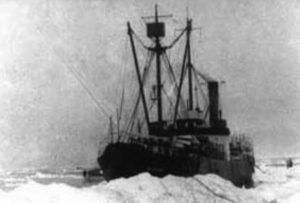 Ghost ships have been a prominent tale of mystery over the years. Many say that seeing a ghost ship is an omen of doom, which I do not believe in, nor do I believe in ghosts or ghost ships, but there was a ship that was dubbed a ghost ship, and has had the longest standing as a possible ghost ship in history, at least to my knowledge. The SS Baychimo was a cargo ship that was built in 1914 in Sweden. It was used for trading routes between Hamburg and Sweden. After World War I, the ship was sold to the Hudson’s Bay Company. The ship made numerous sailings for Hudson’s, mostly carrying cargo to and from the Arctic region.
Ghost ships have been a prominent tale of mystery over the years. Many say that seeing a ghost ship is an omen of doom, which I do not believe in, nor do I believe in ghosts or ghost ships, but there was a ship that was dubbed a ghost ship, and has had the longest standing as a possible ghost ship in history, at least to my knowledge. The SS Baychimo was a cargo ship that was built in 1914 in Sweden. It was used for trading routes between Hamburg and Sweden. After World War I, the ship was sold to the Hudson’s Bay Company. The ship made numerous sailings for Hudson’s, mostly carrying cargo to and from the Arctic region.
The Baychimo had a lucrative career until October 1, 1931, when it was on a routine voyage, filled with recently acquired furs. An unexpected storm blew in, trapping the ship in a sea filled with ice. The closest city was Barrow, Alaska, the northern most city in the United States, and almost like being on top of the world, but it was too far to get to in the blowing snow and high winds. The captain and crew had to stay inside the trapped ship, where they hoped to wait out the storm. This storm was the beginning of the more bizarre part of Baychimo’s life.
When October 15th rolled around, the ship could still be found stuck in the ice, so 15 of the crew members were airlifted to safety. The captain and 14 other crew members made a temporary camp on the ice near the stranded ship…which turned out to be a very wise decision. The terrible weather continued to pound the crew and the “temporary” camp became home for weeks. Then, on November 24th, a fierce blizzard hit the area, and the snow was so heavy that the campers could no longer see the Baychimo, which was still trapped in the ice…or so they thought. The next morning, it was just as the expected. The ship had vanished. They assumed that it had been sunk by the preceding blizzard. The remaining crew made their way back to civilization.
Then, less than a week later, a hunter told the captain that the Baychimo could not have sunk, as he had just seen it floating in the icy waters almost fifty miles from the location where it had been abandoned. The captain was, understandably reluctant to battle the snows to try and find the ship, knowing that it could be miles for the last known location. Nevertheless, he gathered his crew and went looking. Just as the hunter had said, they found the Baychimo in the location the hunter had described. The ship looked like it was no longer seaworthy, so the captain didn’t think it would stay afloat much longer and would soon break apart and sink, so the crew gathered the cargo of furs and had everything, including the captain and the crew, airlifted out of the area.
The captain was wrong. The SS Baychimo was spotted again and again. In March of 1933, some Eskimos, trapped by a storm, took shelter in the Baychimo for a week until the weather improved enough to journey back to their homes. In November of 1939, another ship came close enough to the Baychimo that they were 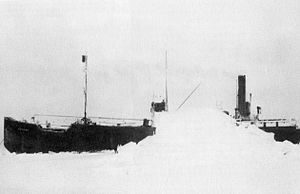 able to board the abandoned ship, but due to the approaching ice floes, the captain did not have the time to bring it back to a port, although he did report the empty ship’s location. In 1969, the Baychimo was spotted at a distance, once again trapped in an ice pack. This was the last recorded sighting of the ship, and after a few years it was commonly believed that the ship did eventually give in to its deteriorating condition and sank to the bottom of the frigid seas. Not everyone agreed though, because in 2006, seventy-five years after the ship was first abandoned, the state of Alaska formally began an effort to find the mysterious SS Baychimo, the Arctic’s elusive wandering ship.
able to board the abandoned ship, but due to the approaching ice floes, the captain did not have the time to bring it back to a port, although he did report the empty ship’s location. In 1969, the Baychimo was spotted at a distance, once again trapped in an ice pack. This was the last recorded sighting of the ship, and after a few years it was commonly believed that the ship did eventually give in to its deteriorating condition and sank to the bottom of the frigid seas. Not everyone agreed though, because in 2006, seventy-five years after the ship was first abandoned, the state of Alaska formally began an effort to find the mysterious SS Baychimo, the Arctic’s elusive wandering ship.
 Since people began moving around the world there was a need for mail service, but people hated to wait months to hear from their loved ones…especially if it was with bad news. There had to be a way to get he mail faster and with the invention of the airplane, in late 1903, the possibility of a new way to deliver the mail was on the horizon. It really didn’t take very long for someone to make the metal leap from driving the mail to flying the mail from place to place. Where there is a need, there must be a solution. That solution came on May 15, 1918, when the United States officially established airmail service between New York and Washington DC, using Army aircraft and pilots. Prior to this date, the Post Office Department used new transportation systems such as railroads or steamboats to transport mail. They contracted with the owners of the lines to carry the mail. There were no commercial airlines to contract with, so no one had thought about that yet, but that was about to change.
Since people began moving around the world there was a need for mail service, but people hated to wait months to hear from their loved ones…especially if it was with bad news. There had to be a way to get he mail faster and with the invention of the airplane, in late 1903, the possibility of a new way to deliver the mail was on the horizon. It really didn’t take very long for someone to make the metal leap from driving the mail to flying the mail from place to place. Where there is a need, there must be a solution. That solution came on May 15, 1918, when the United States officially established airmail service between New York and Washington DC, using Army aircraft and pilots. Prior to this date, the Post Office Department used new transportation systems such as railroads or steamboats to transport mail. They contracted with the owners of the lines to carry the mail. There were no commercial airlines to contract with, so no one had thought about that yet, but that was about to change.
Army Major Reuben H. Fleet was charged with setting up the first US airmail service, scheduled to operate beginning May 15, 1918 between Washington DC, Philadelphia, Pennsylvania, and New York City. The army pilots chosen to fly that day were Lieutenants Howard Culver, Torrey Webb, Walter Miller and Stephen Bonsal, all chosen by Major Fleet, and Lieutenants James Edgerton and George Boyle, both chosen by postal officials. Edgerton and Boyle had only recently graduated from the flight school at Ellington Field, Texas and neither had more than 60 hours of piloting time. While I’m sure they were a bit nervous, I’m also sure they were excited to be standing on the threshold of history.
The project got off to a bit of an embarrassingly rocky start, when Lieutenant Boyle, who was engaged to the daughter of Interstate Commerce Commissioner Charles McChord, was selected to pilot the first plane out of Washington DC that day. After all his preparations, Boyle hopped into his plane and was unable to start it. The plane had not been fueled. I’m sure that added a bit of nervousness to the situation. Nevertheless, he finally got his Curtiss Jenny, loaded with 124 pounds of airmail, into the air and made his way to Washington DC. His assignment was to fly to Philadelphia, the mid-way stop between the Washington and New York ends of the service. He did not make it there that day. The novice pilot got lost and low on gas, crash landed in rural Maryland, less than 25 miles away from Washington.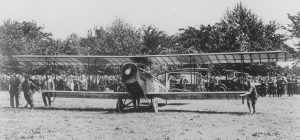
Fortunately for the service, the other flights operated as scheduled that day. Thanks to his political connections, Lieutenant Boyle was given a second chance to fly the airmail out of Washington DC. This time, he was given an escort who flew him out of the city, having given him directions to “follow the Chesapeake Bay” towards Philadelphia. Unfortunately, Boyle followed those instructions too literally, following the curve of the bay over to Maryland’s eastern shore, where he landed, out of fuel again. Not even Boyle’s connections could help him now, and he was removed from the pilots list for the service. I’m sure that didn’t help his standing with his future father-in-law either.
The other rookie pilot, Lieutenant James Edgerton, did much better on his flights and stayed with the service. Edgerton managed to keep his plane aloft during a violent storm that struck while he was on another flight, even as the propeller was pelted by hail. He stayed with the mail service until the next year, and became the Chief of Flying Operations. Then in August, the Post Office Department took over airmail operations with airplanes and civilian pilots of its own. Captain Benjamin Lipsner was named the first superintendent of the U.S. Airmail Service.
The first flight operated by the Post Office Department took off from College Park, Maryland, on August 12, 1918. The destination was New York. Max Miller flew that historic flight. Miller flew the new Curtiss R-4 aircraft. These new planes had more powerful Liberty 400 horsepower engines. Miller was the first pilot hired by the Post Office Department. He died when his plane caught fire and crashed on September 1, 1920. The Post Office Department decided to launch pathfinding flights from New York to Chicago in September 1918. A major obstacle was the Allegheny Mountains, considered by some to be the most dangerous territory on the route. U.S. Airmail Service Superintendent Benjamin Lipsner chose two of his best pilots, Eddie Gardner and Max Miller, for these flights. Eager competitors, Gardner and Miller turned the test into a race. On September 5,  1918, the pair left New York. Miller flew in a Standard airmail plane with a 150-horsepower Hispano-Suiza engine. Gardner followed in a Curtiss R-4 with a 400-horsepower Liberty engine and was accompanied by Eddie Radel, a mechanic. As each pilot landed to refuel or make repairs, he eagerly called Lipsner in Chicago to find out where the other one was. A set of telegrams now in the National Postal Museum tracked their progress. Miller landed in Chicago first, at 6:55 p.m. on September 6. Gardner arrived the next morning, landing at 8:17 at Grant Park. Sometimes it isn’t about the size of the engine I guess. Of course, today, very few people use the postal service, not called “snail mail.” With the internet and texting we have almost instant access to our loved ones.
1918, the pair left New York. Miller flew in a Standard airmail plane with a 150-horsepower Hispano-Suiza engine. Gardner followed in a Curtiss R-4 with a 400-horsepower Liberty engine and was accompanied by Eddie Radel, a mechanic. As each pilot landed to refuel or make repairs, he eagerly called Lipsner in Chicago to find out where the other one was. A set of telegrams now in the National Postal Museum tracked their progress. Miller landed in Chicago first, at 6:55 p.m. on September 6. Gardner arrived the next morning, landing at 8:17 at Grant Park. Sometimes it isn’t about the size of the engine I guess. Of course, today, very few people use the postal service, not called “snail mail.” With the internet and texting we have almost instant access to our loved ones.
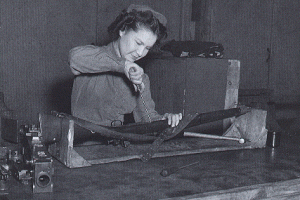
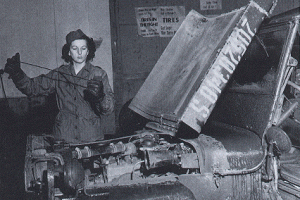 World War II saw many changes in how women were viewed in the normally male-dominated world. With so many men off fighting the war, the women stepped up to do the jobs of riveters in the shipyards, and they stepped up in many other occupations too. If there are no men to do the jobs, someone had to keep the country running, and the United States found out that women were up for the task. I don’t suppose that everyone thought that women could do it, but they simply had no choice. World War II was the largest and most violent armed conflict in the history of mankind. This war taught us, not only about the profession of arms, but also about military preparedness, global strategy, and combined operations in the coalition war against fascism.
World War II saw many changes in how women were viewed in the normally male-dominated world. With so many men off fighting the war, the women stepped up to do the jobs of riveters in the shipyards, and they stepped up in many other occupations too. If there are no men to do the jobs, someone had to keep the country running, and the United States found out that women were up for the task. I don’t suppose that everyone thought that women could do it, but they simply had no choice. World War II was the largest and most violent armed conflict in the history of mankind. This war taught us, not only about the profession of arms, but also about military preparedness, global strategy, and combined operations in the coalition war against fascism.
Prior 1942, the only way for women to be involved in the service was as an Army Nurse, in the Army Nurse Corps, but early in 1941 Congresswoman Edith Nourse Rogers of Massachusetts met with General George C. Marshall, the Army’s Chief of Staff, and told him that she intended to introduce a bill to establish an Army women’s corps, separate and distinct from the existing Army Nurse Corps. Congress approved that bill on May 14, 1942, and the Women’s Army Auxiliary Corps (WAAC) was born. The WAAC bill became law on May 15, 1942. Congressional opposition to the bill centered around southern congressmen. With women in the armed services, one representative asked, “Who will then do the cooking, the washing, the mending, the humble homey tasks to which every woman has devoted herself; who will nurture the children?” These days he would have been run out of Congress for having backward ideas but it was a different time, and one that some women of today truly miss…especially young mothers.
After a long and bitter debate which filled ninety-eight columns in the Congressional Record, the bill finally passed the House 249 to 86. The Senate approved the bill 38 to 27 on May 14. When President Franklin D. Roosevelt signed the bill into law the next day, he set a recruitment goal of 25,000 for the first year. WAAC recruitment topped that goal by November of 1942, at which point Secretary of War Henry L. Stimson authorized WAAC enrollment at 150,000, the original ceiling set by Congress. The day the bill became law, Stimson appointed Oveta Culp Hobby as Director of the WAAC. As chief of the Women’s Interest Section in the Public Relations Bureau at the War Department, Hobby had helped shepherd the WAAC bill through Congress. She had impressed both the media and the public when she testified in favor of the WAAC bill in January. In the words of the Washington Times Herald, “Mrs. Hobby has proved that a competent, efficient woman who works longer days than the sun does not need to look like the popular idea of a competent, efficient woman.” Women would go on to not only become competent and efficient, but requested…sometimes above the men!!
So, what led to the Army’s decision to enlist women during World War II? The answer is simple. The “unfathomable” became reality, as the Army struggled to fulfill wartime quotas from an ever-shrinking pool of candidates. By mid-1943, the Army was simply running out of eligible white men to enlist. The Army could scarcely spare those men already in the service for non-combatant duties. General Dwight D. Eisenhower remarked: “The simple headquarters of a Grant or Lee were gone forever. An Army of filing clerks, stenographers, office managers, telephone operators, and chauffeurs had become essential, and it was scarcely 
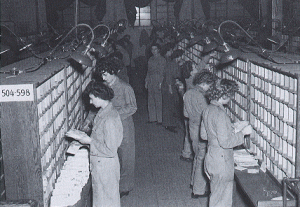 less than criminal to recruit these from needed manpower when great numbers of highly qualified women were available.” While women played a vital role in the success of World War II, their admission into combat roles would not come for many years, and many weren’t sure it was a good idea when it did. The WAC, as a branch of the service, was disbanded in 1978 and all female units were integrated with male units.
less than criminal to recruit these from needed manpower when great numbers of highly qualified women were available.” While women played a vital role in the success of World War II, their admission into combat roles would not come for many years, and many weren’t sure it was a good idea when it did. The WAC, as a branch of the service, was disbanded in 1978 and all female units were integrated with male units.
 My niece, Andrea Spicer is a person who is known for her caring, generous nature. She is always willing to help or a friend or family member in need. Once when a friend of hers left her wallet in a restaurant while they were traveling, Andrea offered to take her all the way back the next day and she would have done it too, but the group decided to turn around and go back right away. This kind of act is not foreign to Andrea, but is rather is something that Andrea is well known for. It doesn’t matter if she’s at work or with friends. Andrea has a caring heart and she lets everyone know that she is there for them.
My niece, Andrea Spicer is a person who is known for her caring, generous nature. She is always willing to help or a friend or family member in need. Once when a friend of hers left her wallet in a restaurant while they were traveling, Andrea offered to take her all the way back the next day and she would have done it too, but the group decided to turn around and go back right away. This kind of act is not foreign to Andrea, but is rather is something that Andrea is well known for. It doesn’t matter if she’s at work or with friends. Andrea has a caring heart and she lets everyone know that she is there for them.
Andrea has worked for the last couple of years at the Turnbuckle Lounge in the Best Western Hotel. She is a cook there and everyone who is are there agrees that she is a great cook and an easy employee to get along with. She lives her job and in reality has always been very interested in cooking. She loves serving people her creations and the watching them enjoy the food she has made. It is another way that her caring nature can come out. Sometimes, showing people how much we care, is displayed in the nutritious food we make for them. 
Of course, the most important thing in Andrea’s life is her son Topher. He is her reason for getting up every day. He is her reason for doing her best in everything she does. Topher puts a smile on her face with his sweet ways, and his silly sense of humor. He makes he smile and he makes her laugh. Topher is, in many ways, Andrea’s best friend. They love to do things together, because they are very close. Sometimes, I think that Andrea, like most parents can’t believe that Topher is becoming a grown up young man, but he is. Time refuses to stand still, and Topher is almost a teenager, but he is. For Andrea, it has been a wonderful life. Today is Andrea’s birthday!! Happy birthday Andrea!! Have a great day!! We love you!!
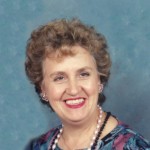 In church today, our pastor talked about how moms can become invisible to their children. Of course, he was talking about how we can take them for granted, but there is another way that our mom can become invisible…at least to us here. When your mom goes to Heaven and you can no longer see her, or talk to her. While she is no longer with us here on earth, that doesn’t mean her love for us ends. Love will endure forever. She was the one who carried us in her womb for nine months, and then brought us into this world. She nurtured us through life, and helped us to become independent people, who can take charge of our own lives.
In church today, our pastor talked about how moms can become invisible to their children. Of course, he was talking about how we can take them for granted, but there is another way that our mom can become invisible…at least to us here. When your mom goes to Heaven and you can no longer see her, or talk to her. While she is no longer with us here on earth, that doesn’t mean her love for us ends. Love will endure forever. She was the one who carried us in her womb for nine months, and then brought us into this world. She nurtured us through life, and helped us to become independent people, who can take charge of our own lives.
I’m sure there were many times when we took her for granted, and didn’t give her the respect she deserved, but she always forgave us for our thoughtlessness. In her wisdom, she knew that we really didn’t mean it. Still, our words must have hurt…our actions must have stung. Nevertheless, Mom forgave and didn’t hold it against us. I’m sure some of them us were much more of a challenge than others, and I place myself in that category, because I think I had the ability to be a trial sometimes…and I think I might be putting that somewhat mildly. Still, that doesn’t mean that I did not care about my mom, but rather that her daughter was stubborn. Mom always forgave me anyway, and for that I consider myself blessed. Our moms taught us what it meant to be parents…the need to forgive our kids for the stupid things we did. We learned parenting from our parents after all, and much of the nurturing qualities come from our mothers. Where would our kids be without our mothers to show us how to be mothers. We learned it from her.
Still, over those years, we have all taken our moms for granted. We didn’t really see them. They were a fixture in our lives. They performed a function, but we were seldom grateful. Then, when they are suddenly gone, we 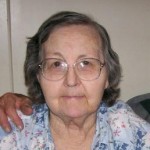 finally get it. We realize that they quietly took care of all the needs of our lives. They took a back seat so that we could shine. They cooked and cleaned, and received no thanks from us. We sassed them and disrespected them, and even though we may have said we were sorry, we could not take those things back. They were forever out there. Then, for some of us, the day came when they left this earth and we learned what it was like without that wonderful person that we had taken so much for granted…viewed as invisible…whether we realized it or not. For us, invisible took on a whole new meaning where our mother was concerned. I was blessed in this life to have a wonderful mom and mother-in-law, and both of them are invisible to me now. They are in Heaven, but they will never be forgotten. Happy Mother’s Day in Heaven to my two moms. I love and miss you both.
finally get it. We realize that they quietly took care of all the needs of our lives. They took a back seat so that we could shine. They cooked and cleaned, and received no thanks from us. We sassed them and disrespected them, and even though we may have said we were sorry, we could not take those things back. They were forever out there. Then, for some of us, the day came when they left this earth and we learned what it was like without that wonderful person that we had taken so much for granted…viewed as invisible…whether we realized it or not. For us, invisible took on a whole new meaning where our mother was concerned. I was blessed in this life to have a wonderful mom and mother-in-law, and both of them are invisible to me now. They are in Heaven, but they will never be forgotten. Happy Mother’s Day in Heaven to my two moms. I love and miss you both.

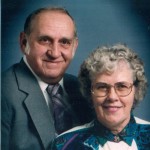 My uncle, Larry Byer was the older of the three middle children of my grandparents, George and Hattie Byer, and a part of the three musketeers that included my mom, Collene Spencer and their brother, Wayne Byer. Uncle Larry was the older of the only two boys in the family, and with my mom in the middle, the three of them were into mischief a lot. While they were in trouble a lot, they were also best friends and allies. If one was in trouble the others tried to help…unless their mom was going to spank them, because they learned early on that you just didn’t mess with their mom.
My uncle, Larry Byer was the older of the three middle children of my grandparents, George and Hattie Byer, and a part of the three musketeers that included my mom, Collene Spencer and their brother, Wayne Byer. Uncle Larry was the older of the only two boys in the family, and with my mom in the middle, the three of them were into mischief a lot. While they were in trouble a lot, they were also best friends and allies. If one was in trouble the others tried to help…unless their mom was going to spank them, because they learned early on that you just didn’t mess with their mom.
Uncle Larry worked at the Texaco refinery for many years, and when they closed down, he was not at retirement age yet, so he took a transfer to New Orleans, Louisiana. He and Aunt Jeanette were gone for a number of years, and the whole family missed them, but several family members took the opportunity to visit them and had a great time in New Orleans. Uncle Larry and Aunt Jeanette treated each of their guests to the best the city had to offer. My parents took the opportunity to visit, and had a great time…once they got used to the heat. While they enjoyed every visit, I’m sure their favorite visitor, other than their children and grandchildren, was his mother. Grandma Byer went to visit, and they gave her the royal tour. The pictures of their visit were memories that Grandma would never forget. When the family went through Grandma’s things, they found he pictures of her visit among her things. They pictures were great, and you could tell that they both fully enjoyed the visit. It was one neither of them would ever forget.


Uncle Larry and Aunt Jeanette were still living in Louisiana when Grandma became ill, but she wanted to say goodbye to all of her children before she went home. She waited until Uncle Larry got home before she passed away. I know that Uncle Larry was always thankful that he made it home…and so was Grandma. Now both of them are together in Heaven, and I know that they are having a great time. Today is Uncle Larry’s birthday. He would have been 84 years old. Happy birthday in Heaven, Uncle Larry. We love and miss you very much.

 A fireman…it seems to be the every little boy’s dream, and my grandson was no exception, but what has made him the exception is the fact that he has gone through all the training to actually become a fire fighter, and he never faltered. Josh began his journey while he was still in high school. He was in his element…immediately. Josh had some wonderful mentors along the way, all of whom made this dream interesting and who confirmed his destination. They helped Josh to know that his dream was the right dream for him.
A fireman…it seems to be the every little boy’s dream, and my grandson was no exception, but what has made him the exception is the fact that he has gone through all the training to actually become a fire fighter, and he never faltered. Josh began his journey while he was still in high school. He was in his element…immediately. Josh had some wonderful mentors along the way, all of whom made this dream interesting and who confirmed his destination. They helped Josh to know that his dream was the right dream for him.
Through the Boces program, Josh started his studies while he was still in high school, and then has continued his studies as a full time college student, achieving his Associates Degree in Fire Science in one year of full time college instead of two. His is looking forward to continued study to become a Paramedic, and he will also be looking into getting hired by one of the local fire departments. He is so excited about that prospect that he can hardly wait. I suppose it is the  same with any course of study. You have learned the things you need to know for your career, and now you are just itching to get at it. That is exactly where Josh is right now…standing on the threshold of his future.
same with any course of study. You have learned the things you need to know for your career, and now you are just itching to get at it. That is exactly where Josh is right now…standing on the threshold of his future.
I have always known that Josh would make a great fire fighter/paramedic, because of the aptitude he displayed as a young boy helping to take care of his great grandparents. He was very meticulous, gentle, and caring. When Josh was helping, they always felt at ease, knowing that he would follow directions exactly and would always be careful with them. Josh has always had a heart for caregiving, and firefighter/paramedic falls right in line with caregiving, so as a career choice, it makes perfect sense. Today is the culmination of Josh’s dream and hard work, as he graduates with an Associates Degree in Fire Science. Congratulations Josh!! We are so proud of you and all your hard work!!
 My niece, Jessi Sawdon began her working career in the legal field, as a runner in an attorney’s office. Most kids don’t really have that opportunity so early on, but Jessi was blessed and she was a great employee. She continued on in the legal field until the attorney she was working for at the time retired, and then she decided that it was time for a change, so she went back to school. She has been studying, and together with her husband, Jason and been raising their little girl Adelaide. Being a stay-at-home mom has been very important to Jessi since the birth of her little girl, so I’m sure that going back to college to start a new career was little bit scary too…mostly wondering what a job would bring as far as her mommy life was concerned.
My niece, Jessi Sawdon began her working career in the legal field, as a runner in an attorney’s office. Most kids don’t really have that opportunity so early on, but Jessi was blessed and she was a great employee. She continued on in the legal field until the attorney she was working for at the time retired, and then she decided that it was time for a change, so she went back to school. She has been studying, and together with her husband, Jason and been raising their little girl Adelaide. Being a stay-at-home mom has been very important to Jessi since the birth of her little girl, so I’m sure that going back to college to start a new career was little bit scary too…mostly wondering what a job would bring as far as her mommy life was concerned.
Today, with her studies behind her, Jessi has achieved her Associates Degree in Human Communications, and just started a new job as the Marketing Coordinator for Hinge Studio Marketing and Communications. The business is owned by two of her very good friends, Kerstin and Leah, and the really good news is that Jessi will be working from home. There is nothing better that to have bosses who are also your  good friends, and who understand your needs and are willing to work with you to make your mutual dreams come true. I think there are a number of people who would love to be in Jessi’s shoes when it comes to their job, because you don’t have to give up your time with your children for your job. Now I call that working it out!!
good friends, and who understand your needs and are willing to work with you to make your mutual dreams come true. I think there are a number of people who would love to be in Jessi’s shoes when it comes to their job, because you don’t have to give up your time with your children for your job. Now I call that working it out!!
Today, with commencement upon her, Jessi is looking forward to marching with her class to receive her degree, and we are all so very proud of her. The studies are behind her now, and it is smooth sailing ahead. Jessi, we are all so proud of you and of all the hard work you have do to achieve your goal. Now with a new career ahead of you, the best is yet to be. Congratulations on your graduation, Jessi!! We love you!!

 My older sister is without doubt, one of the nicest people I know. She is always careful of peoples feelings, and is generous to a fault. If she can help someone, she will help them. Cheryl is just a very caring person. She gave up much of her time to take care of our parents when they were ill, and often takes her youngest granddaughter, Aleesia for the evening, so that her parents can go to the summertime activities in downtown Casper with their sons. I’m sure that one day Aleesia will choose to go with them, but he loves her grandma very much and loves spending time with her.
My older sister is without doubt, one of the nicest people I know. She is always careful of peoples feelings, and is generous to a fault. If she can help someone, she will help them. Cheryl is just a very caring person. She gave up much of her time to take care of our parents when they were ill, and often takes her youngest granddaughter, Aleesia for the evening, so that her parents can go to the summertime activities in downtown Casper with their sons. I’m sure that one day Aleesia will choose to go with them, but he loves her grandma very much and loves spending time with her.
Cheryl is a legal secretary for Williams, Porter, Day and Neville legal firm, and works for one of the busiest attorneys there, often working late hours to get everything done that needs to be done that day. She is very good at her job, and the attorney she works for has said that he would be lost without her, and really wishes  she could see her way clear to refusing such things as vacation, because it is a real hardship for him when she is gone. Nevertheless, he has to persevere, because everyone needs a vacation.
she could see her way clear to refusing such things as vacation, because it is a real hardship for him when she is gone. Nevertheless, he has to persevere, because everyone needs a vacation.
Cheryl is a big fan of old movies or chic flicks, and so every Thursday night, she and I go to dinner with her daughter, Liz, and then we go back to her house and watch a movie. She and I don’t always agree on what makes a good movie, but usually we do. She has pretty good taste in movies…once you get away from things like “The Sound of Music” anyway. I know she would roll her eyes at me on that one, but there are just some shows that I can’t get into. Nevertheless, she got me going on the “Love Comes Softly” series, and “Sarah, Plain and Tall,” both of which I really enjoy. That sister time is really important to both of us, as we are very close, and we like to keep it that way. We have been good friends (and sisters) all our lives, and we don’t see any reason to change that now. Today is Cheryl’s birthday. Happy birthday Cheryl!! Have a great day!! We love you!!
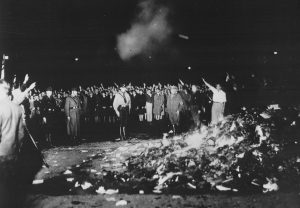 Book burning is the ritual destruction by fire of books or other written materials. This practice is usually carried out in a public place, so as to further destroy any sense of control of one’s own life. The burning of books represents an element of censorship and usually proceeds from a cultural, religious, or political opposition to the materials in question. Sometimes those burning the books think they are “protecting” the people from something they deem to be evil, but more often, the books simply don’t agree with the agenda of the controlling group. Such was the case with the most famous book burning, which took place under the Nazi regime on May 10, 1933. The May 1933 book burning in Nazi Germany was preceded in nineteenth century Germany. In 1817, German student associations (Burschenschaften) chose the 300th anniversary of Luther’s 95 Theses to hold a festival at the Wartburg, a castle in Thuringia where Luther had sought sanctuary after his excommunication. The students were demonstrating for a unified country. Germany was then a patchwork of states. During the protest, the students burned anti-national and reactionary texts and literature which the students viewed as “Un-German” in nature or content. I wonder if they had any idea that the freedom to protest was the very thing they were looking to take away in the future Germany.
Book burning is the ritual destruction by fire of books or other written materials. This practice is usually carried out in a public place, so as to further destroy any sense of control of one’s own life. The burning of books represents an element of censorship and usually proceeds from a cultural, religious, or political opposition to the materials in question. Sometimes those burning the books think they are “protecting” the people from something they deem to be evil, but more often, the books simply don’t agree with the agenda of the controlling group. Such was the case with the most famous book burning, which took place under the Nazi regime on May 10, 1933. The May 1933 book burning in Nazi Germany was preceded in nineteenth century Germany. In 1817, German student associations (Burschenschaften) chose the 300th anniversary of Luther’s 95 Theses to hold a festival at the Wartburg, a castle in Thuringia where Luther had sought sanctuary after his excommunication. The students were demonstrating for a unified country. Germany was then a patchwork of states. During the protest, the students burned anti-national and reactionary texts and literature which the students viewed as “Un-German” in nature or content. I wonder if they had any idea that the freedom to protest was the very thing they were looking to take away in the future Germany.
Then, in 1933, Nazi German authorities, decided to synchronize professional and cultural organizations with Nazi ideology and policy (Gleichschaltung). Nazi Minister for Popular Enlightenment and Propaganda, Joseph Goebbels, spearheaded an effort to bring German arts and culture in line with Nazi goals. The government began to remove cultural organizations of Jewish and other officials who were alleged to be politically suspect or who performed or created art works which Nazi ideologues labeled “degenerate.” Goebbels also had a strong ally in the National Socialist German Students’ Association (Nationalsozialistischer Deutscher Studentenbund), so he used them to bring the literary phase into being. German university students were at the forefront of the early Nazi movement, and in the late 1920s. Many of them filled the ranks of various Nazi formations. The ultra-nationalism and antisemitism of middle-class, secular student organizations had been intense and vocal for decades. After World War I, many students opposed the Weimar Republic (1919–1933) and found in National Socialism a suitable vehicle for their political discontent and hostility.
On April 6, 1933, the Nazi German Student Association’s Main Office for Press and Propaganda proclaimed a nationwide “Action against the Un-German Spirit,” to end in a literary purge or “cleansing” (Säuberung) by fire. Local chapters were to supply the press with releases and commissioned articles, offer blacklists of “un-German” authors, sponsor well-known Nazi figures to speak at public gatherings, and negotiate for radio broadcast time. Then, in a symbolic act of ominous significance, on May 10, 1933, university students burned upwards of 25,000 volumes of “un-German” books, presaging an era of state censorship and control of culture. On the evening of May 10, in most university towns, right-wing students marched in torchlight parades “against the un-German spirit.” The scripted rituals called for high Nazi officials, professors, university rectors, and university student leaders to address the participants and spectators. In Berlin, some 40,000 persons gathered  in the Opernplatz to hear Joseph Goebbels delivered a fiery address: “No to decadence and moral corruption!” He went on to say, “Yes to decency and morality in family and state! I consign to the flames the writings of Heinrich Mann, Ernst Gläser, Erich Kästner.” Among the authors whose books student leaders burned that night were well-known socialists such as Bertolt Brecht and August Bebel; the founder of the concept of communism, Karl Marx; critical “bourgeois” writers like the Austrian playwright Arthur Schnitzler; and “corrupting foreign influences,” among them American author Ernest Hemingway. I don’t agree with some of these writings, but I also don’t agree with their destruction. People can make up their own minds.
in the Opernplatz to hear Joseph Goebbels delivered a fiery address: “No to decadence and moral corruption!” He went on to say, “Yes to decency and morality in family and state! I consign to the flames the writings of Heinrich Mann, Ernst Gläser, Erich Kästner.” Among the authors whose books student leaders burned that night were well-known socialists such as Bertolt Brecht and August Bebel; the founder of the concept of communism, Karl Marx; critical “bourgeois” writers like the Austrian playwright Arthur Schnitzler; and “corrupting foreign influences,” among them American author Ernest Hemingway. I don’t agree with some of these writings, but I also don’t agree with their destruction. People can make up their own minds.

